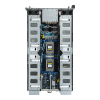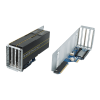I am about to build some inference GPU servers. This will be my first time dealing with server-grade hardware and I have some questions.
Requirements and background info:
1. The servers should support Epyc CPUs and multiple double-slot blower-style Nvidia consumer GPUs (ie 2080 Ti).
2. Price is a major factor.
3. Storage and networking requirements are modest by server standards (a drive or two and 10 GbE will be enough).
4. The servers will be colocated (after a trial run at home).
5. There will eventually be many servers over many years.
6. I live and run my business in Europe (Hungary).
7. I have browsed around a bunch but have not started to negotiate with any vendors yet.
8. I've built several compute-intensive home servers with consumer parts over the years.
9. I don't plan to get any "official" support, and will just RMA anything that fails and deal with it myself (for cost reasons).
The server I like best is the Gigabyte G242-Z10 (G242-Z10 (rev. 100) | High Performance Computing System - GIGABYTE Global). I like the density, the extra-wide GPU slots, and the airflow. However, two things give me pause:
a. I like the idea of going with Supermicro for future-proofing (modular approach, company exclusively dedicated to the server space) and quality (based on various internet comments), but Supermicro doesn't currently seem to have great options for Epyc GPU servers. The only two Supermicro Epyc GPU servers which look reasonable are the 2023US-TR4 (2u, 2p, 2 GPUs) and the 4124GS-TNR (4u, 2p, 8 GPUs), but the former only supports two double-slot GPUs per server and the latter isn't available yet and seems to require a hump for consumer GPU power delivery.
b. The price of the Gigabyte G242-Z10 seems a bit high (based on browsing the internet, not contacting anyone). The lowest price I've found online is around $2200 (w/o VAT).
The server I like second-best is the Tyan TN83-B8215 (https://www.tyan.com/Barebones_TN83B8251_B8251T83E8HR-2T-N), but it has the same drawbacks as the Gigabyte G242-Z10. The lowest list price I've found for the Tyan TN83-B8215 is $2800 (w/o VAT).
The cheapest suitable server I've found online is the HPE ProLiant DL385 Gen 10. This wouldn't be my first choice, but it would be good enough and some of the prices I'm seeing for this server are crazy low:
$980 for 500 Watt PSU and an Epyc 7251: PROVANTAGE: HPE 878712-B21 HPE Proliant DL385 Gen10 EPYC 7251 8-Core 16GB 8LFF E208i-A 500W 3-Year
$2790 for 800 Watt PSU and a Epyc 7452: PROVANTAGE: HPE P16693-B21 HPE Proliant DL385 Gen10 AMD EPYC 7452 32-Core 16GB 24SFF P408i-A 800W 3-Year
These HPE ProLiant DL 385 Gen 10 versions don't have the Gen 10+ improvements (ie PCIe 4) but that's ok.
My questions:
1. How much should I optimize for getting the type of server I want now versus trying to pick a vendor for the long haul.
2. How good a long-term vendors are Gigabyte and Tyan. I've found a ton of info about HPE, Dell and Supermicro but very little about Gigabyte and Tyan as server vendors.
3. Am I missing something with those HP ProLiant DL385 deals? They seem incredibly good. Can I negotiate something comparable for the Gigabyte G242-Z10 or Tyan TN83-B8215?
4. How willing should I be to purchase servers in the US and have them shipped to Europe? I've done this many times with consumer hardware and use Stackry for a forwarding address. Would this be too cumbersome for this kind of hardware?
5. Another server I have my eyes on is the Gigabyte G292-Z42 (G292-Z42 (rev. 100) | High Performance Computing System - GIGABYTE Global), which packs 8 double-width GPU slots into 2u. This would actually be my first choice due to the incredible density and cost per GPU but I suspect that the cooling requires passive server-grade GPUs and just wouldn't be able to handle eight 200+ Watt consumer blower-style GPUs. Is there any way to find out if this is a feasible option?
6. Another idea I've been toying around with is building the servers myself, crypto-mining-rig style, by getting deep 4u cases and motherboards like the Supermicro H11SSL and running PCIe x8 and x16 extenders off those motherboard to the GPUs in the front of the cases. This would save some money up front, although with higher colocation costs. Does this sound reasonable?
7. I'm also seeing some really good deals for engineering sample Epyc CPUs on ebay. Often the seller states very specific motherboard compatibility. Should those usually work in other motherboards? Is there anything I should be wary of with such offers?
8. Any other feedback is welcome.
Ok, that's a lot of questions. Thanks in advance for any help!
Requirements and background info:
1. The servers should support Epyc CPUs and multiple double-slot blower-style Nvidia consumer GPUs (ie 2080 Ti).
2. Price is a major factor.
3. Storage and networking requirements are modest by server standards (a drive or two and 10 GbE will be enough).
4. The servers will be colocated (after a trial run at home).
5. There will eventually be many servers over many years.
6. I live and run my business in Europe (Hungary).
7. I have browsed around a bunch but have not started to negotiate with any vendors yet.
8. I've built several compute-intensive home servers with consumer parts over the years.
9. I don't plan to get any "official" support, and will just RMA anything that fails and deal with it myself (for cost reasons).
The server I like best is the Gigabyte G242-Z10 (G242-Z10 (rev. 100) | High Performance Computing System - GIGABYTE Global). I like the density, the extra-wide GPU slots, and the airflow. However, two things give me pause:
a. I like the idea of going with Supermicro for future-proofing (modular approach, company exclusively dedicated to the server space) and quality (based on various internet comments), but Supermicro doesn't currently seem to have great options for Epyc GPU servers. The only two Supermicro Epyc GPU servers which look reasonable are the 2023US-TR4 (2u, 2p, 2 GPUs) and the 4124GS-TNR (4u, 2p, 8 GPUs), but the former only supports two double-slot GPUs per server and the latter isn't available yet and seems to require a hump for consumer GPU power delivery.
b. The price of the Gigabyte G242-Z10 seems a bit high (based on browsing the internet, not contacting anyone). The lowest price I've found online is around $2200 (w/o VAT).
The server I like second-best is the Tyan TN83-B8215 (https://www.tyan.com/Barebones_TN83B8251_B8251T83E8HR-2T-N), but it has the same drawbacks as the Gigabyte G242-Z10. The lowest list price I've found for the Tyan TN83-B8215 is $2800 (w/o VAT).
The cheapest suitable server I've found online is the HPE ProLiant DL385 Gen 10. This wouldn't be my first choice, but it would be good enough and some of the prices I'm seeing for this server are crazy low:
$980 for 500 Watt PSU and an Epyc 7251: PROVANTAGE: HPE 878712-B21 HPE Proliant DL385 Gen10 EPYC 7251 8-Core 16GB 8LFF E208i-A 500W 3-Year
$2790 for 800 Watt PSU and a Epyc 7452: PROVANTAGE: HPE P16693-B21 HPE Proliant DL385 Gen10 AMD EPYC 7452 32-Core 16GB 24SFF P408i-A 800W 3-Year
These HPE ProLiant DL 385 Gen 10 versions don't have the Gen 10+ improvements (ie PCIe 4) but that's ok.
My questions:
1. How much should I optimize for getting the type of server I want now versus trying to pick a vendor for the long haul.
2. How good a long-term vendors are Gigabyte and Tyan. I've found a ton of info about HPE, Dell and Supermicro but very little about Gigabyte and Tyan as server vendors.
3. Am I missing something with those HP ProLiant DL385 deals? They seem incredibly good. Can I negotiate something comparable for the Gigabyte G242-Z10 or Tyan TN83-B8215?
4. How willing should I be to purchase servers in the US and have them shipped to Europe? I've done this many times with consumer hardware and use Stackry for a forwarding address. Would this be too cumbersome for this kind of hardware?
5. Another server I have my eyes on is the Gigabyte G292-Z42 (G292-Z42 (rev. 100) | High Performance Computing System - GIGABYTE Global), which packs 8 double-width GPU slots into 2u. This would actually be my first choice due to the incredible density and cost per GPU but I suspect that the cooling requires passive server-grade GPUs and just wouldn't be able to handle eight 200+ Watt consumer blower-style GPUs. Is there any way to find out if this is a feasible option?
6. Another idea I've been toying around with is building the servers myself, crypto-mining-rig style, by getting deep 4u cases and motherboards like the Supermicro H11SSL and running PCIe x8 and x16 extenders off those motherboard to the GPUs in the front of the cases. This would save some money up front, although with higher colocation costs. Does this sound reasonable?
7. I'm also seeing some really good deals for engineering sample Epyc CPUs on ebay. Often the seller states very specific motherboard compatibility. Should those usually work in other motherboards? Is there anything I should be wary of with such offers?
8. Any other feedback is welcome.
Ok, that's a lot of questions. Thanks in advance for any help!





